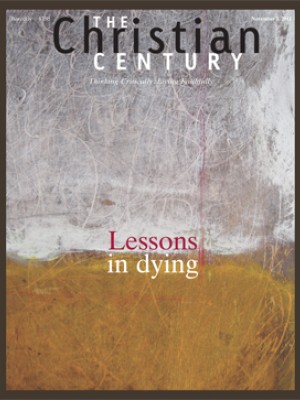Plain-talk Bible debuts with mainstream backing
The Common English Bible, the newest Bible on the block, is what the name suggests—a translation into commonly spoken English. It is not the first edition to move in that direction. But it's probably the first to use contractions so extensively—whether it's King David, Jesus or Paul speaking. Except when announcing the Ten Commandments, even God says "don't" in giving Moses added prohibitions for the Israelites.
This new Bible is not as wordy as others—about 30,000 fewer words—apparently because of its use of contractions and its attention to sentence length, among other factors.
Like other recent Bible versions, the CEB substitutes brothers and sisters for brethren, to mention one of the easiest steps toward inclusive language. But the CEB may not have to dodge the slings and arrows of biblical fundamentalists that greeted the evangelically aimed Today's New International Version in recent years. For one thing, the Common English Bible was endorsed in April for use at the eight-campus Fuller Theological Seminary along with the New Revised Standard Version and TNIV (expected to be replaced by a new NIV edition).
Read our latest issue or browse back issues.
Fuller professor Joel B. Green is the New Testament editor for CEB, but he said it was cofaculty member Daniel Kirk, another CEB translator, who commended the new Bible to the seminary. Kirk said the translations are "academically excellent" and reflect "the reality that the communities for which the Bible was written consist of both men and women."
The CEB is clearly aimed at the broad middle of Protestantism. The Christian Resources Development Corporation, formed as a distinct corporation in Nashville by the United Methodist Publishing House, promotes the CEB as a "common ground" project. It used 120 translators from two dozen different denominations.
Recognizing that a gender-inclusive and innovative translation would be most welcome to mainline churches, publishers for five denominations in the National Council of Churches serve as CEB's "sponsors." Besides the Methodist-related Abingdon Press, the group includes the Presbyterians' Westminster John Knox Press, the Disciples of Christ's Chalice Press, the United Church of Christ's Pilgrim Press and the Episcopalians' Church Publishing, Inc.
Spokespersons for the Presbyterian, Disciples and UCC publishers said they have had little involvement in the CEB so far other than having translators from their denomination working on CEB editions. However, bishops, clergy and laity at the Episcopal General Convention next July in Indianapolis will receive CEBs in hopes that the new translation will be authorized for use in the denomination, according to Davis Perkins, who heads Church Publishing, Inc.
Involved in the CEB project from the start, Perkins said: "I have no doubt the CEB will find broad utility in the church and take its place alongside the NRSV as an esteemed translation that will enrich all dimensions of church life."
Some scholars who requested anonymity have wondered if the CEB project will impact NRSV sales given the long association of mainline churches with the RSV and NRSV—translations sponsored by the National Council of Churches.
"There is always room for fresh and contemporary translations," said David M. Dobson, executive director of the Presbyterians' WJK Press, adding that new versions enhance further understanding of scripture. "We continue to be supportive of the NRSV translation."
"We're not irked by the Common English Bible project," said the NCC's media relations specialist, Philip Jenks, in an e-mail interview. "We made our peace long ago with the fact that there are other versions of the Bible on the market," Jenks said.
New Testament scholar Richard L. Jeske, who is on the NCC's translation and utilization committee, said, "I think the jury is still out on the Common English Bible." Jeske said that the CEB's apparent target audience is U.S. Protestants, whereas the RSV/NRSV also used Catholic and Orthodox translators. "Sales of the RSV continue to be robust internationally." CEB officials noted, however, that 11 of its translators are Catholic.
The CEB "never arose in our discussions" when the committee met in February, he said. The NCC group has been discussing whether to revise the 1989 NRSV in a new edition or to launch a new translation, but has not yet reached a decision, he said.
One remarkable aspect of the CEB was its swift production. In contrast to the deliberate pace of past biblical translations, this one took only four years from its 2007 start to the debut of the full Bible in August. Though hundreds of readability experts provided feedback, the computer age sped up the process, officials said.
Credit for getting the CEB out so fast—the New Testament appeared in print a year ago—is given to associate publisher Paul Franklyn, who earned his doctorate in Old Testament at Vanderbilt University and has specialized in developing and editing various products at Abingdon Press. Franklyn was the CEB's "spiritual and intellectual leader" who guided all facets of the project, said Neil M. Alexander, publisher of CEB and the United Methodist Publishing House.
Franklyn indicated in an e-mail that any suggestion of a rivalry between the CEB and the National Council of Churches is misleading. Abingdon continues to contract with the NCC for use of its NRSV translations and has published the NCC's Yearbook of American and Canadian Churches for decades. Mainline Protestants are not told by their denominations that they must use a particular translation of the Bible, he added.
With more than 500,000 copies already in print, the Common English Bible has specialty editions in the works. A Bible dictionary and a Daily Companion Bible are next, plus a reference edition in January, a children's edition in August and a study Bible in print by fall 2013.
This article was amended on October 18. A sentence was added at the end of the 12th paragraph.






